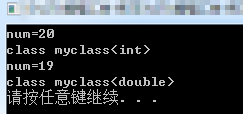1. 类模板的默认参数规则:
#include <iostream> using namespace std; /* //类模板,不调用不编译(函数);变量还是规范 template<class T = int> //即使参数默认,调用的时候还是要指明类型 class myclass { public: T a; T b; T add() { return a + b; } }; int main() { myclass<int> my; my.a = 10; my.b = 20; my.add(); system("pause"); return 0; } */ template<class T1, class T2 = double, class T3 = char> //默认参数,原则上都放在右边 class myclassT { public: }; int main() { myclassT<int> my1; //<>无论如何都不能省略, //有默认参数原则上可以省略;如果中间出现一个没有省略,需输入若干参数,覆盖那个位置 system("pause"); return 0; }
2. 类模板的嵌套:
#include <iostream> #include <vector> #include <list> using namespace std; /* //类的怀孕现象 class my { public: class zi //嵌套类 { }; zi z1; }; */ template<class T> class myT { public: template<class T> //嵌套类模板 class ziT { T a; public: void seta(T t) { a = t; } T geta() { return a; } }; ziT<int> my1; //无论外部什么类型,始终都是int ziT<T> my2; //外部什么类型,内部也是该类型 vector<T> myv; list<T> myx; }; int main() { myT<double> d1; system("pause"); return 0; }
3. 模板参数的嵌套:
#include <iostream> #include <vector> #include <list> #include <string> using namespace std; /* int main() { vector<int> myint1; vector< vector<int> > myint2; //二维数组 vector< vector< vector<int> > > myint3; //三位数组 system("pause"); return 0; } */ template<class T> class men { public: men() { } ~men() { } T getAge() { return age; } T getName() { return name; } void setAge(T && a) { age = a; } void setName(T & n) { name = n; } private: T name; T age; }; template<template<class T>class T1> //此时 T1 <==> men class people { public: T1<int> s1; //T1<int> <==> men<int> T1<string> s2; people() { } ~people() { } }; int main() { people<men> chinese; chinese.s1.setAge(50); cout << chinese.s1.getAge() << endl; chinese.s2.setAge("中国人"); cout << chinese.s2.getAge() << endl; system("pause"); return 0; }

4. 模板与友元函数:
4.1 类模板 与 友元函数模板:
#include <iostream> using namespace std; template<class T> class myclass { public: myclass(T m, T n):a(m),b(n) { } ~myclass() { } private: T a; T b; template<class T> friend void show(myclass<T> my); //友元函数声明,声明也必须带上template friend void show(myclass<double> my); //明确类型的调用 }; template<class T> void show(myclass<T> my) { cout << my.a << " " << my.b << endl; } void show(myclass<double> my) { } int main() { myclass<int> my1(29, 39); show(my1); system("pause"); return 0; }

4.2 类模板 与 友元类模板:
#include <iostream> using namespace std; template<class T> class showit; //先声明showit类,引用友元类,创建引用或指针,唯独不能创建对象 template<class T> class myclass { public: myclass(T m, T n) :a(m), b(n) { } private: T a; T b; friend class showit<T>; //声明友元类,该类为一个类模板 }; template<class T> class showit { public: myclass<T> *p; void set(T a, T b) { p = new myclass<T>(a, b); cout << p->a << " " << p->b << endl; } }; int main() { showit<int> showit1; showit1.set(99, 87); system("pause"); return 0; }

5. 类模板与static静态成员:
#include <iostream> using namespace std; template<class T> class myclass { public: //静态成员不属于这个类,它在静态区,不能将其值设定在内部, //static int num = 0; //error C2864: “myclass<T>::num”: 带有类内初始值设定项的静态 数据成员 必须具有不可变的常量整型 static int num; myclass() { num += 1; } ~myclass() { num -= 1; } void show() { cout << "num=" << num << endl; cout << typeid(*this).name() << endl; } }; template<class T> int myclass<T>::num = 0; //static成员,每个类型实例化都会创建一个变量;类型一致,共享;类型不一致,私有。 int main() { myclass<int> *p1 = new myclass<int>[10]; //调用10次构造函数 myclass<int> *p3 = new myclass<int>[10]; p1->show(); //20 类型一致,共享 myclass<double> *p2 = new myclass<double>[19]; p2->show(); //19 类型不一致 system("pause"); return 0; }

6. 类模板与static静态成员函数:
6.1 static静态成员函数没有this指针:
#include <iostream> using namespace std; template<class T> class myclass { public: void go1() { this; } static void go2() //静态成员函数的指针类型不一样,没有this指针 { } }; int main() { auto fun1 = &myclass<int>::go1; auto fun2 = &myclass<int>::go2; //成员函数与静态成员函数最大区别,函数指针类型不一样,静态成员函数没有this指针 cout << typeid(fun1).name() << endl; cout << typeid(fun2).name() << endl; myclass<char> mych; system("pause"); return 0; }

6.2 静态成员函数无需创建对象就可调用:
#include <iostream> using namespace std; template<class T> class myclass { public: void go1() { cout << "go1" << endl; } static void go2() //静态成员函数的指针类型不一样,没有this指针 { cout << "go2" << endl; } }; int main() { myclass<int>::go2(); //静态成员函数,无需创建对象就可以直接调用(既可以创建对象来调用,也可以不创建对象来调用) //myclass<int>::go1(); myclass<int> my1; my1.go1(); my1.go2(); system("pause"); return 0; }
